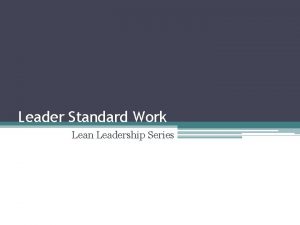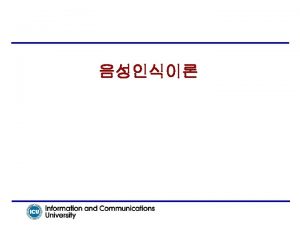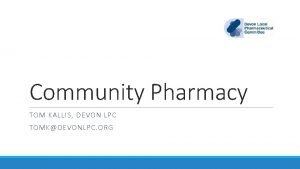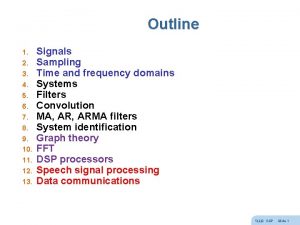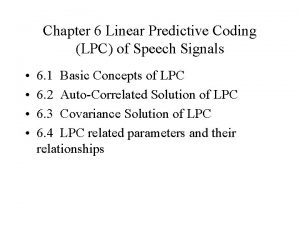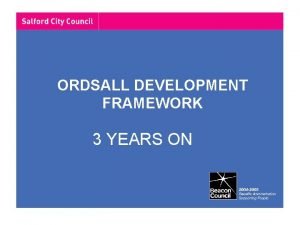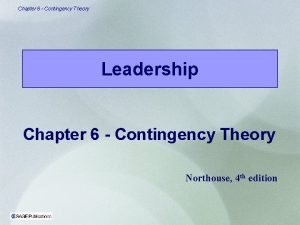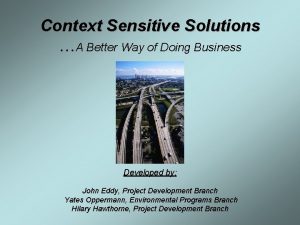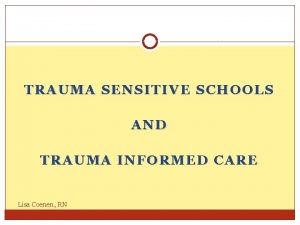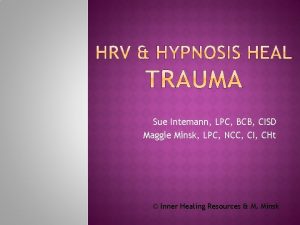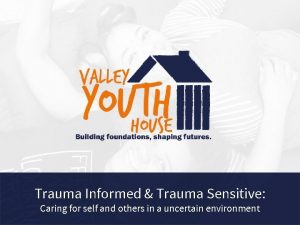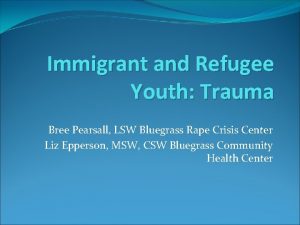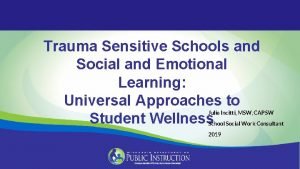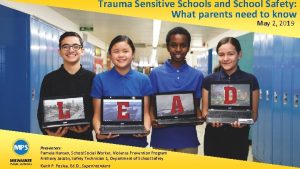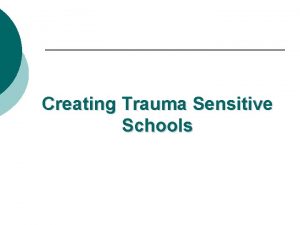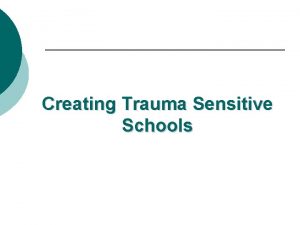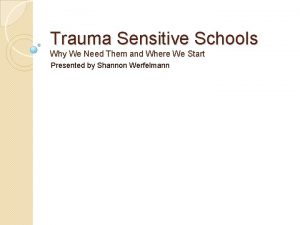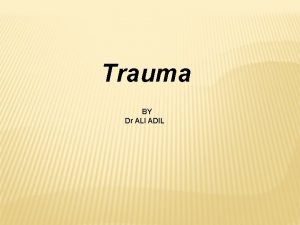Trauma Sensitive Schools Karen Yost MA LSW LPC



























- Slides: 27

Trauma Sensitive Schools Karen Yost, MA, LSW, LPC, NCC, ALPS, MAC, CCDVC, CSOTS Prestera Center for Mental Health Services 1

Have you ever had a student who was… �irritable or hostile? �avoidant of school? �chronically poor in self-care health 2 habits? �exhibiting confusion or poor memory when being questioned? �stoic and reluctant to admit to problems, or extremely needy and/or demanding? �presenting with a history of alcohol/substance abuse, depressive symptoms, chronic relationship difficulties ?

You Are Not Alone! �Youth with histories of trauma are likely to present to schools with some (or many) of these characteristics. �Their behavior can interfere with learning, student-teacher communication, impede compliance with instructions/rules, and generally, frustrate the school staff. �More importantly, these youth are at high risk for academic failure and deteriorating health. Most youth who have experienced trauma do not seek mental health services. 3

Trauma is the key but is rarely on the 4

Trauma Defined… �“an emotional shock that creates significant and lasting damage to a person’s mental, physical and emotional growth. ” �Traumatic experiences can significantly alter a person’s perception of themselves, their environment, and the people around them. In effect, trauma changes the way people view themselves, others and their world. �Can impact safety, well-being, permanence. 5

Prevalence � 70‐ 80% of mental health clients have severe trauma histories � In state hospitals, estimates range up to 95% � 90% or more of women in jails and prisons are victims of physical or sexual abuse � Up to 2/3 of men and women in substance abuse treatment report childhood abuse or neglect � Similar statistics exist for foster care, juvenile justice, homeless shelters, welfare programs, etc � Boys who experience or witness violence are 1000 times 6 more likely to commit violence

Trauma is… �NOT a diagnostic category �A series of experiences that elicits feelings of terror, powerlessness, & out-of-control psychological arousal; result in survival driven behaviors, thoughts, emotions, & needs. �Often misinterpreted & assigned as symptoms of disorders (depression, Bipolar Disorder, ADHD, Oppositional Defiant Disorder, Conduct Disorder, Attachment Disorder, etc. ). �These diagnoses generally do not capture full extent of 7 developmental impact of trauma.

Exposure to Trauma can be: • A single event • A connected series of events • Chronic lasting stress Trauma is under-reported and under-diagnosed. (NTAC, 2004) 8

Types of Traumatic Experiences � Loss of a loved one � Serious medical Illness � Abandonment � Physical abuse � Accidents � Sexual abuse � Homelessness � Emotional/verbal abuse � Community/school � Man-made or natural violence � Bullying, including cyber -bullying � Domestic violence � Neglect � Frequent moves 9 disasters � Witnessing violence � Terrorism � Refugee and War Zone trauma

Types of Trauma A single traumatic event that is limited in time. The experience of multiple traumatic events. Acute Trauma Chronic Trauma Vicarious Trauma Complex Trauma Both exposure to chronic trauma, and the impact such exposure has on an individual. 10 System Induced Trauma The traumatic removal from home, admission to a detention or residential facility or multiple placements within a short time.

Trauma can occur at any age. 11 Trauma can impact anyone.

Impact of Trauma Over the Life Span ACE Study - effects are neurological, biological, psychological and social in nature, including: � Changes in neurobiology � Social, emotional and cognitive impairment � Adoption of health-risk behaviors as coping mechanisms � Severe and persistent 12 behavioral health, physical health, social problems, and early death (Felitti)

Adverse childhood experiences increase the risk of: Heart Disease 4 or more traumatic experiences shorten life expectancy by 20 years Immune Diseases Adverse Childhood Experienc es Liver Disease Cancer Diabetes 13 Chronic Lung Disease

Adverse childhood experiences increase the risk of: Mental Illness 4 or more traumatic experiences shorten life expectancy by 20 years 14 Suicide Adverse Childhood Experienc es Relationship Problems Behavio Substan r ce Proble Abuse Poor ms Self. Esteem

Trauma & Cognitive Disability �Trauma interferes with the interpretation and communication functions of the brain, leading to non-verbal communication and misinterpretation of non-verbal signals (language). • Complex trauma/PTSD interferes with a person’s ability to store and retrieve information (memory). • Understanding brain development and functioning helps decipher how the person is interpreting the world around him/her. 15

Impact on Learning & School Behavior �Loss of pleasure in learning & displays inconsistent 16 or little effort �Belief that they are not smart - especially LD students �Re-live the painful, burning memories of shaming experiences �Exhibit chronic, habitual anger toward teachers and those in authority �Inconsistent attendance/truancy �Low appetite for risk-taking academically and in other areas (“I don’t care”) �Behavior problems

A word about punishment… �A U. S. Department of Education-sponsored research study acknowledges that punishment, "including reprimands, loss of privileges, office referrals, suspensions, and expulsions, " is ineffective, "especially when it is used inconsistently and in the absence of other positive strategies". �“Teaching behavioral expectations and rewarding students for following them is a much more positive approach than waiting for misbehavior to occur before responding. " 17

School Punishment �U. S. schools suspend millions of kids -- 3, 328, 750 in 2006 & 30, 750 for WV �Since the 1970 s, the suspension rates have nearly doubled for white kids, to nearly 6%; has more than doubled for Hispanics to 7 percent; to 15% for African Americans; For Native Americans, it's almost tripled, from 3% to 8%. National Education Policy Center Report, October 2011 18

More Data �If you think all these suspensions are for weapons and drugs, recalibrate. � There's been a kind of "zero-tolerance creep" since schools adopted "zero-tolerance" policies. Only 5% of all out-of-school suspensions were for weapons or drugs, said the NEPC report, 2006. � The other 95% were categorized as "disruptive behavior" and "other", which includes violation of dress code, or being "defiant". 19

The Reality… �More importantly, they don't work for traumatized kids. �These "throw-away" kids get shunted off a track to college or vocational school and onto the deadend spur of juvenile hall and prison. �One suspension triples the likelihood of a child 20 becoming involved with the juvenile justice system, and doubles the likelihood of a child repeating a grade. And those suspensions begin early.

TRAUMA-SENSITIVE CARE Provides the foundation for a basic understanding of the psychological, neurological, biological, and social impact that trauma and violence have on many people. “What’s wrong with you? ” 21 Incorporates proven practices into current operations to deliver services that acknowledge the role that violence and victimization play in the lives of most of the individuals entering our systems. “What happened to you? ”

A Culture Shift: Core Principles of a Trauma- Sensitive System �Safety: Ensuring physical and emotional safety �Trustworthiness: Maximizing trustworthiness, making tasks clear, and maintaining appropriate boundaries �Choice: Prioritizing choice and control �Collaboration: Maximizing collaboration and sharing of power with students �Empowerment: Prioritizing student empowerment and skill-building 22

What Can a School Staff Do? �Recognize that exposure to trauma is the rule, not the exception, among children in the child welfare system. �Recognize the signs, symptoms & cumulative effect of child traumatic stress and how they vary in different age groups. �Recognize that children’s “bad” behavior is sometimes an adaptation to trauma. �Understand the impact of trauma on different developmental domains. �Help other staff understand how their own communication style brings on behavior that hinders learning (disruption, passivity, anxiety). 23

What Can a School Staff Do? �Recognize that education system responses/interventions have the potential to either exacerbate or decrease the impact of previous traumas. �Lessen the risk of system-induced secondary trauma by serving as a protective and stress-reducing buffer for children. �Develop trust with children through listening, frequent contacts, and honesty in order to mitigate previous traumatic stress. �Avoid making professional promises that, if unfulfilled, are likely to increase traumatization. 24

Guiding Values of Trauma-Informed Care “Healing Happens in Relationship” 25

Thoughts from Helen Keller The extraordinary Helen Keller, despite being blind and deaf, achieved so much in her life. She once said: “The world is moved not only by the mighty shoves of the heroes, but also by the aggregate of the tiny pushes of each honest worker. ” Each of you is a “honest worker” caring and giving so much of yourselves to help others. If you all push a little you can move mountains and yourselves. You are so intertwined, you caregivers and your care recipients, that rules and regulations that are aimed at helping them also help you, and rules and regulations that are designed to help you also help them. 26

Questions? Karen Yost, MA, LSW, LPC, NCC, ALPS, MAC, CCDVC, CSOTS Prestera Center for Mental Health Services 27
 Leaders standard work
Leaders standard work Reach schools safety schools and
Reach schools safety schools and Huntsville city schools powerschool
Huntsville city schools powerschool Thomson reuters lpc
Thomson reuters lpc Lpc 10
Lpc 10 Lpc vs lpcc
Lpc vs lpcc Lpc skala
Lpc skala Baucar gaji
Baucar gaji Lpc collateral
Lpc collateral Devon lpc
Devon lpc Lpc vocoder
Lpc vocoder Lpc debug port
Lpc debug port Lpc hrss
Lpc hrss Vita 57
Vita 57 Lpc linear predictive coding
Lpc linear predictive coding Hulton square ordsall
Hulton square ordsall Lpc matlab code
Lpc matlab code Linux vocoder
Linux vocoder Tees lpc
Tees lpc Cpcps
Cpcps Lpc scale contingency theory
Lpc scale contingency theory Channel vocoder block diagram explanation
Channel vocoder block diagram explanation Lpc matlab code example
Lpc matlab code example Lpc vocoder
Lpc vocoder Silicone sensitive areas
Silicone sensitive areas What does context sensitive solutions mean?
What does context sensitive solutions mean? Critical period vs sensitive period
Critical period vs sensitive period Disclaimer for sensitive content
Disclaimer for sensitive content
